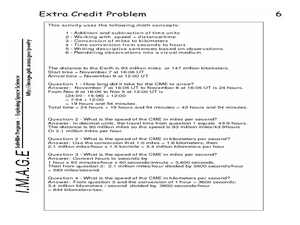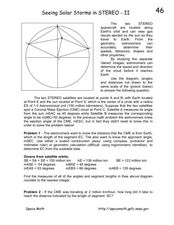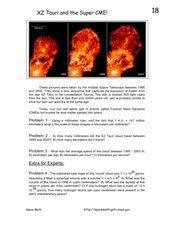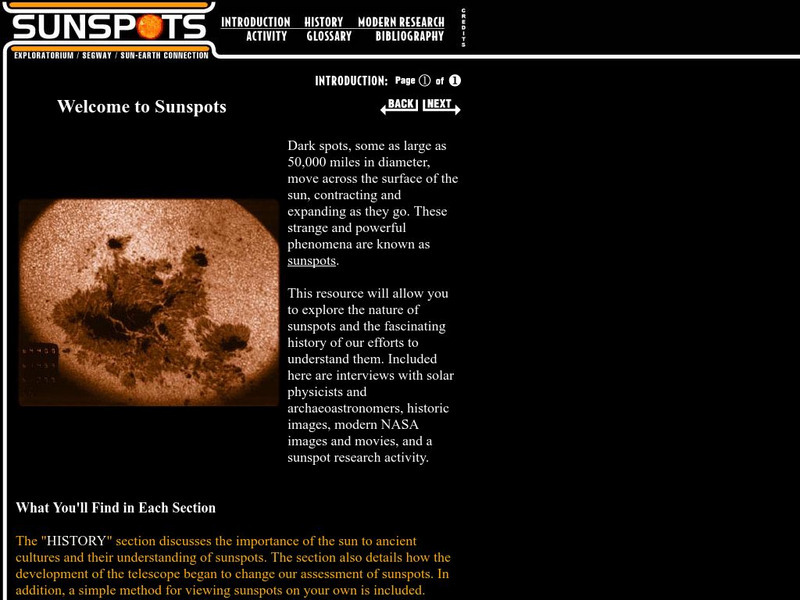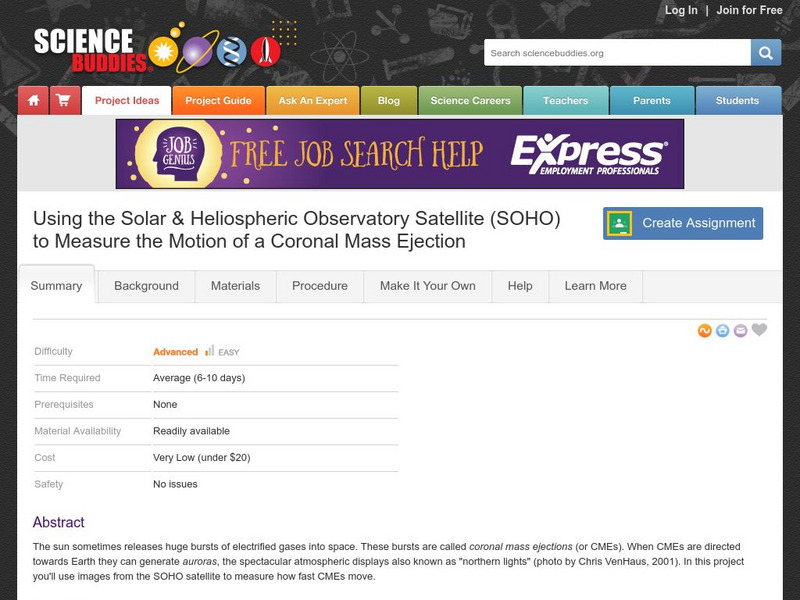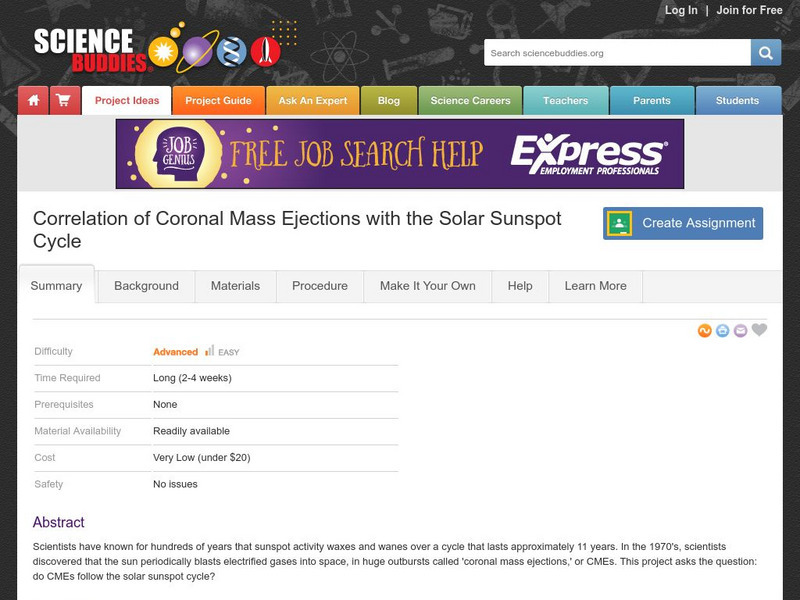PBS
NOVA Sun Lab Lesson Plan
Looking for a sun-sational multi-lesson plan full of videos, simulations, and discussion? Introduce your young scientists to all things solar with a four-part hands-on adventure. Pupils learn the basics of solar anatomy, space weather,...
K20 LEARN
This Is How the World Ends: Coronal Mass Ejections/Space Storms
Is this the end of the world as we know it? Pupils prepare for a coronal mass ejection during a lesson from the K20 Center. The activity combines video and Internet research in a collaborative assignment that focuses on public safety...
PHET
CME Plotting
Young scientists build on their previous knowledge and apply it to coronal mass ejections. By plotting the path of two different coronal mass ejections, they develop an understanding of why most don't collide with Earth.
Curated OER
Measuring Speed in the Universe
In this measuring speed in the universe activity, students use photographs of 3 astronomical phenomena including supernova explosions, coronal mass ejections and solar flare shock waves to find how fast they move. The photographs show...
Curated OER
Do Fast CMEs Produce Intense SPEs?
In this coronal mass ejections and Solar Proton Events activity, learners create a Venn Diagram to represent given data. They answer 5 questions about the data related to the number of coronal mass ejections and Solar Proton Events...
Curated OER
Solar Flares and Coronal Mass Ejections
In this solar flares and coronal mass ejections worksheet, students create a Venn Diagram with given data about solar flares and Halo CMEs. Students answer 6 questions about the events and the probability of each type of event occurring...
Curated OER
Solar and Auroral Events
In this solar and auroral events learning exercise, students answer 5 questions about a coronal mass ejection that traveled to the Earth. They find the time it took to arrive and they determine the speed of the coronal mass ejection in...
Curated OER
Solar Storms: Odds, Fractions and Percentages
In this solar storms worksheet, students read about the correlation between different astronomical events to find patters and new 'laws' of nature. Students use given statistical information about solar flares and coronal mass ejections...
Curated OER
Seeing Solar Storms in STEREO-II
In this solar storms learning exercise, students use a diagram given the location of two STEREO spacecraft satellites, a coronal mass ejection, the sun and the Earth to solve 2 problems about the coronal mass ejection. Students use...
Curated OER
A Bird's Eye Look at the Sun-Earth System
In this Sun-Earth system worksheet, students fill in blanks with the proper terms from a given list to complete a summary of the relationship between the Sun and the Earth. A major topic includes how solar storms effect the Earth and the...
Curated OER
Coronal Mass Ejections
In this coronal mass ejections activity, students observe a time line of events that took place during a solar storm. Kids use the time line to answer 3 questions about the solar storm and the time it took to reach Earth. Students...
Curated OER
Time Intervals
In this time intervals worksheet, students solve 8 problems where they determine the time gamma-ray bursts last, the time black hole micro-flares are emitted, the time coronal mass ejections travel and the days between lunar phases of...
Curated OER
XZ Tauri and The Super CME!
In this XZ Tauri and coronal mass ejections worksheet, students use 3 photographs taken by the Hubble Space Telescope to solve 4 problems. They find the scale of the images, they determine the number of kilometers the XZ Tauri cloud...
Curated OER
An application of the Parallax Effect
For this parallax effect worksheet, students observe 2 photographs taken of an active area of the sun by 2 STEREO satellites and 1 photograph taken of the same active area of the sun by the SOHO satellite. Students observe the shift in...
Curated OER
CME Kinetic Energy and Mass
In this kinetic energy and mass worksheet, students read about coronal mass ejections detected by the SOHO satellite. Students complete a data table that shows the relationship between kinetic energy, speed and mass. They convert the...
Curated OER
Solar Storms-Fractions and Percentages
In this solar storms worksheet, students find the percentage of X-Flares and Halo CMEs that occurred in solar storms and complete a Venn Diagram comparing the numbers of each.
University of California
Sunspots: The Exploratorium's Guide to Sunspots
Examine active X-Ray regions on the sun and the possible relationship to the sunspot cycle. Through an interactive exercise and readings, you are guided through the history of our Sun! Worksheets, assessments, and more are included.
Science Buddies
Science Buddies: Observatory Satellite Measures Motion of Coronal Mass Ejection
The sun sometimes releases huge bursts of electrified gases into space. These bursts are called coronal mass ejections (or CMEs). When CMEs are directed towards Earth they can generate auroras, the spectacular atmospheric displays also...
Science Buddies
Science Buddies: Correlation of Coronal Mass Ejections With Solar Sunspot Cycle
Scientists have known for hundreds of years that sunspot activity waxes and wanes over a cycle that lasts approximately 11 years. In the 1970's, scientists discovered that the sun periodically blasts electrified gases into space, in huge...
Other
Space weather.com
Want to know what the current weather conditions are in space? Find everything here you may want to know about the latest solar flares, sunspots, asteroids and more. Site also includes essential web links to quench any user's thirst for...
NOAA
Noaa: Space Weather Prediction Center: A Primer on Space Weather
The Space Environment Center put together an introduction to our sun and space weather that it creates during it's 11 year weather cycle. Learn about different solar anomalies and the effects they have on earth with pipelines, geologic...
Exploratorium
Exploratorium: Auroras Paintings in the Sky
This site offers a very nice, detailed explanation of auroras along with some inspiring images and videos.
Exploratorium
Exploratorium: Solar Max 2000
Examines the solar maximum cycle that occurred in the year 2000. Describes the characteristics of sunspots, solar flares, and coronal mass ejections, using video, photographs, news reports, and similar resources.
NASA
Nasa: Mission Science: Space Weather 101
Find out about space weather, including coronal mass ejections and solar flares, which are caused by all kinds of different types of solar activity.








